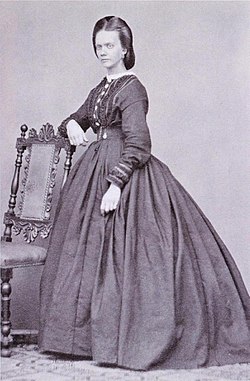Top Qs
Timeline
Chat
Perspective
Victorine Nordenswan
Finnish artist (1838–1872) From Wikipedia, the free encyclopedia
Remove ads
Victorine Nordenswan (14 June 1838 - 25 August 1872) was a Finnish painter in the Düsseldorf tradition, specialising in religious themes, and notable as one of the first professional female artists of Finland.[2]
Remove ads
Early life and education
Hildur Antoinette Victorine Nordenswan was born on 1 June 1838 in Hämeenlinna, Grand Duchy of Finland, the third child and second daughter of Jacobina Fredrica von Numers (1808-1879) and embassy counsellor Johan Henrik Nordenswan (1801-1862).[3]
Nordenswan received her initial education at a girls' school in Hämeenlinna, followed by attending an art school run by painters Berndt Godenhjelm (1799-1881) and Erik Johan Löfgren in the early 1860s. She trained at the Royal Swedish Academy of Fine Arts in Stockholm in 1860–1862.[1][4] In 1864 she went to Düsseldorf, where she became a private pupil of Otto Mengelberg and Eduard Gebhardt.[3] During the winters of 1867/1869 and 1869/1870 Nordenswan travelled back to Finland and returned once more during the Franco-Prussian War.[3]
Remove ads
Career
Visual art in the mid-19th century was male-dominated, but Nordenswan was considered to be exceptionally talented, and widely expected to make a significant career as an artist.[2]
Nordenswan's public debut of her work was in 1861, and she won in the Finnish Art Society's Ducat Contest the second prize in 1865, followed by the first prize in 1867.[4]
Among her best-known works are St. John the Evangelist (1866) and Women Mourning at Christ’s Grave (1868), both today housed at the Finnish National Gallery.[5]
Nordenswan's promising career was cut short by her death from tuberculosis at the early age of 34.[2]
Remove ads
Gallery
- St. John the Evangelist (1866)
- Women Mourning at Christ’s Grave (1868)
- St. Agnes of Rome, copy after Jusepe de Ribera, detail, 1868
References
Wikiwand - on
Seamless Wikipedia browsing. On steroids.
Remove ads




